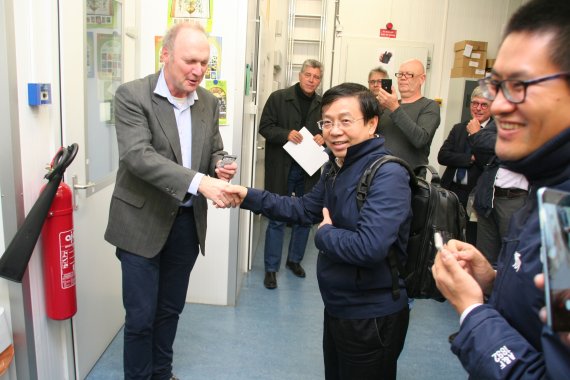Theo van Hintum presents Yonghong Mei, president of BGI Agricultural Group in China, with the first bag of lettuce seed. © Erik Toussaint
The CGN, which is part of the Plant Sciences Group, has made an agreement with BGI (formerly Beijing Genomics Institute) in China. The institute will map the genome of the lettuce variants that are in CGN’s gene bank free of charge. The gene bank has 2500 ‘accessions’ (locations) of wild and cultivated lettuce that could have interesting properties for vegetable breeders. After sequencing at the Chinese institute, these genetic variations will become available to breeders and researchers around the globe.
Lead in knowledge
The Chinese genomics institute does ask for something in return for the free service. The CGN will wait 18 months after the conclusion of the project before allowing its clients access to the digital lettuce genomes. WUR and BGI will have that time to get a lead in the development of methods for finding interesting genes for new lettuce species.
Huge dataset
Theo van Hintum, cluster leader of CGN, is extremely pleased with the agreement. ‘We will acquire a huge dataset with genetic information on lettuce, allowing us to keep our services at the forefront of the field. This information will give us the possibility to much better predict which lettuce accessions will have disease immunities, for example, allowing us to screen fewer variants to find the required property. Additionally, we will better understand the diversity of our lettuce collection, meaning we will be able to more effectively sample, manage and transfer the biodiversity to the following generations.’
Translating
Through the agreement with BGI, CGN will be the world’s first gene bank to have such a large dataset of DNA sequences at its disposal. Van Hintum: ‘That dataset will still need to be translated into relevant information. The methodology to achieve that has not yet been developed.’
He does not mind that BGI will also have access to the huge dataset of lettuce genes. The Chinese institute could also simply have requested the lettuce variants and mapped them for themselves, as the variants are publicly available. ‘They wouldn’t have had to share the results if they had chosen that approach, but they preferred to collaborate.’ In that same train of thought, WUR could have sequenced the lettuce variants locally, but that would have taken much longer, as BGI has many more sequencing machines at its disposal.

